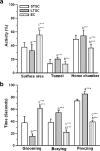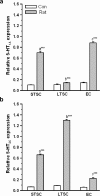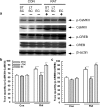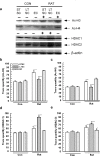Environmental Enrichment Reduces Anxiety by Differentially Activating Serotonergic and Neuropeptide Y (NPY)-Ergic System in Indian Field Mouse (Mus booduga): An Animal Model of Post-Traumatic Stress Disorder
- PMID: 26016844
- PMCID: PMC4446351
- DOI: 10.1371/journal.pone.0127945
Environmental Enrichment Reduces Anxiety by Differentially Activating Serotonergic and Neuropeptide Y (NPY)-Ergic System in Indian Field Mouse (Mus booduga): An Animal Model of Post-Traumatic Stress Disorder
Abstract
Exposure to a predator elicits an innate fear response and mimics several behavioral disorders related to post-traumatic stress disorder (PTSD). The protective role of an enriched condition (EC) against psychogenic stressors in various animal models has been well documented. However, this condition has not been tested in field mice in the context of PTSD. In this study, we show that field mice (Mus booduga) housed under EC exhibit predominantly proactive and less reactive behavior compared with mice housed under standard conditions (SC) during exposure to their natural predator (field rat Rattus rattus). Furthermore, we observed that EC mice displayed less anxiety-like behavior in an elevated plus maze (EPM) and light/dark-box after exposure to the predator (7 hrs/7 days). In EC mice, predator exposure elevated the level of serotonin (5-Hydroxytrypamine, [5-HT]) in the amygdala as part of the coping response. Subsequently, the serotonin transporter (SERT) and 5-HT1A receptor were up-regulated significantly, but the same did not occur in the 5-HT2C receptor, which is associated with the activation of calmodulin-dependent protein kinase-II (CaMKII) and a transcription factor cAMP response element binding protein (CREB). Our results show that predator exposure induced the activation of CaMKII/CREB, which is accompanied with increased levels of histone acetylation (H3, H4) and decreased histone deacetylases (HDAC1, 2). Subsequently, in the amygdala, the transcription of brain-derived neurotrophic factor (BDNF), neuropeptide Y (NPY) and its Y1 receptor were up-regulated, whereas the Y2 receptor was down-regulated. Therefore, EC facilitated a coping response against a fear associated cue in a PTSD animal model and reduced anxiety by differentially activating serotonergic and NPY-ergic systems.
Conflict of interest statement
Figures








Similar articles
-
Neuropeptide Y (NPY) and posttraumatic stress disorder (PTSD): A translational update.Exp Neurol. 2016 Oct;284(Pt B):196-210. doi: 10.1016/j.expneurol.2016.06.020. Epub 2016 Jul 2. Exp Neurol. 2016. PMID: 27377319 Free PMC article. Review.
-
The neuropeptide Y (NPY)-ergic system is associated with behavioral resilience to stress exposure in an animal model of post-traumatic stress disorder.Neuropsychopharmacology. 2012 Jan;37(2):350-63. doi: 10.1038/npp.2011.230. Epub 2011 Oct 5. Neuropsychopharmacology. 2012. PMID: 21976046 Free PMC article.
-
Re-exposure and environmental enrichment reveal NPY-Y1 as a possible target for post-traumatic stress disorder.Neuropharmacology. 2012 Sep;63(4):733-42. doi: 10.1016/j.neuropharm.2012.05.028. Epub 2012 May 29. Neuropharmacology. 2012. PMID: 22659471
-
Serotonergic innervation and serotonin receptor expression of NPY-producing neurons in the rat lateral and basolateral amygdaloid nuclei.Brain Struct Funct. 2013 Mar;218(2):421-35. doi: 10.1007/s00429-012-0406-5. Epub 2012 Apr 17. Brain Struct Funct. 2013. PMID: 22527118 Free PMC article.
-
The role of Neuropeptide Y in fear conditioning and extinction.Neuropeptides. 2016 Feb;55:111-26. doi: 10.1016/j.npep.2015.09.007. Epub 2015 Sep 25. Neuropeptides. 2016. PMID: 26444585 Review.
Cited by
-
The Medial Prefrontal Cortex, Nucleus Accumbens, Basolateral Amygdala, and Hippocampus Regulate the Amelioration of Environmental Enrichment and Cue in Fear Behavior in the Animal Model of PTSD.Behav Neurol. 2022 Feb 7;2022:7331714. doi: 10.1155/2022/7331714. eCollection 2022. Behav Neurol. 2022. PMID: 35178125 Free PMC article.
-
Neuropeptide Y (NPY) and posttraumatic stress disorder (PTSD): A translational update.Exp Neurol. 2016 Oct;284(Pt B):196-210. doi: 10.1016/j.expneurol.2016.06.020. Epub 2016 Jul 2. Exp Neurol. 2016. PMID: 27377319 Free PMC article. Review.
-
Differential impact of stress and environmental enrichment on corticolimbic circuits.Pharmacol Biochem Behav. 2020 Oct;197:172993. doi: 10.1016/j.pbb.2020.172993. Epub 2020 Jul 11. Pharmacol Biochem Behav. 2020. PMID: 32659243 Free PMC article. Review.
-
Environmental enrichment: a neurostimulatory approach to aging and ischemic stroke recovery and rehabilitation.Biogerontology. 2025 Apr 16;26(3):92. doi: 10.1007/s10522-025-10232-z. Biogerontology. 2025. PMID: 40237879 Review.
-
Standardized Bacopa monnieri Extract Ameliorates Learning and Memory Impairments through Synaptic Protein, Neurogranin, Pro-and Mature BDNF Signaling, and HPA Axis in Prenatally Stressed Rat Offspring.Antioxidants (Basel). 2020 Dec 4;9(12):1229. doi: 10.3390/antiox9121229. Antioxidants (Basel). 2020. PMID: 33291595 Free PMC article.
References
-
- Adamec R, Kent P, Anisman H, Shallow, Merali Z (1998) Neural plasticity, neuropeptides and anxiety in animals: implications for understanding and treating affective disorder following traumatic stress in humans. Neurosci Biobehav Rev 23: 301–318. - PubMed
-
- Adamec RE, Blundell J, Burton P (2005) Neural circuit changes mediating lasting brain and behavioral response to predator stress. Neurosci Biobehav Rev 29:1225–1241. - PubMed
-
- Takahashi LK, Nakashima BR, Hong H, Watanabe K (2005) The smell of danger: a behavioral and neural analysis of predator odor-induced fear. Neurosci Biobehav Rev 29:1157–1167. - PubMed
-
- Takahashi LK, Hubbard DT, Lee I, Dar Y, Sipes SM (2007) Predator odor-induced conditioned fear involves the basolateral and medial amygdala. Behav Neurosci 121:100–110. - PubMed
Publication types
MeSH terms
Substances
LinkOut - more resources
Full Text Sources
Other Literature Sources
Medical
Molecular Biology Databases
Research Materials
Miscellaneous

